HMM-165 Events Diary
Our mission was to build a helicopter squadron and deploy aboard the USS Iwo Jima for amphibious operations. Our organization and a Battalion Landing Team would be the first Marine Amphibious Ready Group deployed in Southeast Asia during the Vietnamese War. We were building our Squadron in Okinawa for deployment as soon as possible. Stateside helicopter pilots and helicopter maintenance personnel were flying into Kadena Air Force Base and busing down the island to the air station at Futema. Futema is one the best government facilities anywhere. Barracks, BOQ, Clubs and working spaces are all first class. As good as the facilities are, we were going to find that most of our aircraft were in poor condition. We didn t know it at the time, but the War in Vietnam was on the decline. Aviation and Ground Marines in Vietnam were going to be re-deployed stateside in the near future. We were going to get some of the in-country aircraft and some of their personnel replacements. Some Marines in Southeast Asia were going to be sea-going Marines again.
New personnel checked-in at the first building just inside the main gate at the top of the hill. The hill outside the main gate is a big hill. You better have good brakes if you own a private vehicle. The personnel department processes your orders and directed you to your new squadron. The road leaves the main gate area and circles counter-clockwise through the administrative and service area. You continue around the end of the runway and drive up the other side. That side of the runway has the operational squadrons, hangars, tower and access to aircraft. The bus service between both sides of the runway was excellent. The first squadron on the operational side of the runway was a VMO unit. Their aircraft looked like they were in storage. The OV10 Bronco landing gear can have a leakage problem in one landing gear and not in the other. The result is aircraft that sits at an odd angle on the ramp. If the aircraft maintain that position day after day, they were probably in storage. The second squadron down the road was a medium helicopter squadron like ours. The third squadron down the road was Marine Medium Helicopter Squadron 165 with Major R. F. Smith acting as the Officer in Charge.
The Squadron had 4 or 5 CH-46D aircraft when I arrived. They looked pretty bad. Most aircraft in Okinawa were hi-time veterans of Vietnam. Our aircraft type had an overhaul facility in Japan that was over 600 miles from Okinawa. With a maximum range of only 200 miles, we needed extended range internal tanks to make that long ferry trip to Japan. It takes a brave crew to fly an old aircraft over open water for that distance. Bringing an overhauled aircraft back to Okinawa was almost as bad. Our squadron needed 12 CH-46D aircraft with low time engines, transmissions and rotor blades and we needed them in a hurry. I don t think our ship would leave without us, but we did have an urgent mission to perform. We also needed 4 CH-53D aircraft and 4 UH1E aircraft to complete our composite squadron inventory. The parent Squadrons were preparing their aircraft for transfer to us before departure. We were hoping that we could fly and operate as a composite squadron before we actually embarked aboard ship. Our current big problem was the CH-46D aircraft because they were behind the power curve when it came to aircraft condition and availability.
The CH-46 helicopter has been a workhorse in Southeast Asia since 1965. The CH-46A model went to war as a new aircraft. All new model aircraft validate their design and function during their first deployment. The CH-46A failed when the engines failed after being damaged by the Vietnamese sand in the landing zones.
The CH-53D didn t have any major design problems other than size. It s a big aircraft to maintain no matter where you are. Parts replacement can be a problem because they are very large. Re-supply at sea can be difficult. This large helicopter needs a land based supply point when possible. The CH-53A model had a history of maintenance problems and its reliability was poor. The CH-53D was a big improvement and I m not sure why. Any aircraft that can fly several flights without going down is my kind of aircraft. The CH-53D s reliability was very good.
Our UH1E aircraft were old aircraft. They would be replaced with the UH1N and the Bell Cobra helicopters sometime in the next 2 to 3 years.
As a maintenance activity, we were going to need the 4 fundamental components of any good maintenance plan for 3 different aircraft. Qualified personnel, replacement parts and the right tools and publications are the fundamental components for any successful maintenance plan. We like to look at aviation maintenance as a 4-wheeled vehicle. It can t run on 3 wheels. You need all 4 wheels on the ground to make it work. The four wheels of our maintenance plan were personnel, parts, publications and tools for the three different aircraft. The next level of maintenance up the ladder (shipboard aircraft maintenance) has the same requirements. Failures in their maintenance system could be reduced by a good supply system.
A big part of the deployment puzzle was personnel. The senior pilots were experienced, well qualified and Vietnam veterans. The junior pilots were well trained and motivated. They were not Vietnam veterans. The same experience levels held true for the maintenance department. Our Non Commission Officers were Vietnam veterans with lots of experience. We had a full complement of these talented individuals. The junior troops were motivated Marines that did what they were told. A good attribute for a junior Marine. What we didn t know at that time was how good they were. It takes time to evaluate maintenance personnel and we had the time on the boat. Every Squadron and Maintenance Department has their strong and weak points. We were going to be better off than I realized. Lieutenant Colonel Herther came aboard as our Commanding Officer and Major Smith became our Squadron Executive Officer.
The First Marine Wing in Japan was controlling our incoming aircraft and spare parts. Our resources were all over Southeast Asia. The Philippines, Japan and Vietnam all had resources. Some parts were in transit from the States and others were on their way home. The way the Wing made this remote control system work is with a daily status report from us. It was a painful document. It was easy to make mistakes because the aircraft were in a constant state of change. I think we had one person at Wing that did the status report and that s all he did. After the Wing provided the parts and sometimes an overhauled aircraft, we installed the parts or had to go get the aircraft. We had our hands full.
We were blessed with an understanding Maintenance Officer that had lots of hours in the CH-46D. Every flight he flew in Okinawa was a test hop. We changed blades, transmissions, engines, heads and anything else that would make an aircraft a low-time machine for our deployment. And then we had a typhoon. We had 10 aircraft at that time and our aircraft safety procedure for typhoons was to fly our aircraft 10 miles to a concrete Army warehouse. Put the aircraft inside and then pull them out and fly them back after the typhoon had passed. We had 5 aircraft that could fly. We had 5 aircraft that didn t have all the parts needed for flight. We had one big hangar queen that arrived the day before being pulled by a tug. So we decided to do it the hard way. The 5 flying aircraft departed for the warehouse. We cannibalized the parts we needed at the warehouse with Maintenance Control doing the paper work at the warehouse. We flew one aircraft back with the parts and installed what we needed on the 5 down aircraft. The flights to the warehouse with the 5 down aircraft were test hops. We reversed the drill after the typhoon passed. Good paper work and good maintenance made it work. That exercise should have reduced my worry about our inexperienced troops. They did well.
Aircraft that don t fold blades every day normally do not have an operational blade folding system. The pilots were instructed to fold blades after every hop at Futema because rotor blades have to fold aboard ship. You would normally never fold blades in Vietnam and you will always fold blades on a ship. Making the system work at Futema would reduce our maintenance problems on the boat. Another important system that must be operational is the auxiliary power unit or the APU. This is a small jet engine in the tail of the aircraft that supplies electrical and hydraulic power to the aircraft for starting the engines. The APU has to start and run if the aircraft is going to fly. Ours needed to be reliable with low hours. We didn t want APU problems on the boat.
The anti-war environment and the youth culture back home did cause some problems with our junior troops. This was a Corps wide problem during this difficult period of time. We know that when a Marine graduates from Boot Camp, they act like, look like and even smell like a Marine. That hasn t changed since the first Marine. The way we handled our personnel problems during our first few months was with a good cop, bad cop routine. We would and did hold close order drill on the ramp for selected personnel when required. The basic lesson was that you take orders without giving your superiors any lip. Our young Marines had received some of the best technical training available through the Naval Aviation Training Detachment organization and they had all graduated from Boot Camp. Our personnel problems disappeared when we moved from Okinawa to the ship.
The USS Iwo Jima was berthed at Naval Air Station, San Diego, CA. The Squadron sent a liaison person to San Diego to talk aircraft maintenance with the ship s personnel. The ship had a sailing date and was almost ready to go. The ship was going to sail from San Diego to Okinawa with one stop at Pearl Harbor. We were going to embark at White Beach in Okinawa. The Squadron would embark by air and the Battalion would board from the dock. The ship was well equipped and ready for deployment. The ship had an exceptional aviation supply officer. He was smart, experienced and motivated. We suspected that most of the parts needed to maintain our aircraft would come through the Ship's supply system. The shops on the Iwo Jima could repair most hydraulic components like struts and actuators. Black boxes might be repaired? Engines, rotor heads and transmissions are normally exchanged with the supply system. They could do inspections and small repairs on major components. A rebuild for those parts can t happen aboard ship. The same thing applies to rotor blades. A damaged rotor blade needs to be exchanged with a land based supply system. Our liaison person sailed with the ship from San Diego to Pearl and then flew commercial air from Pearl to Okinawa. The ship was looking good and we only had 2 weeks before we embarked for the big cruise.
We had 3 or 4 overhauled aircraft that had a new good looking paint job and then we had several Vietnam veterans that really looked bad. Our aircraft didn t look the same and we were not very uniform. The big question was, could we paint our ugly ducklings before we left Futema? The Navy wouldn t like us painting our aircraft on their hangar deck. Our young troops from the Metal Shop worked day and night and made us look good. They completed the job before we embarked. The attached units moved their aircraft to our flight line and we started operating as a composite squadron. The CH-53D detachment had some senior maintenance people with lots of experience. The situation was looking better all the time. The UH1E detachment had fewer senior maintenance people, but they were armed with Captain Harry and a crew of young motivated Marines. Captain Harry was a pilot with a bunch of maintenance experience and he could motivate his crew. I think the individual detachments help motivate the rest of the Squadron.
The next big question was whether we could launch 20 aircraft and find a home on the big boat at White Beach. We moved our organizational gear and our personal gear to a pick-up point on the ramp. Of course we were going to take a few motor bikes for personal transportation. An aircraft would move into the staging area and load our gear, then taxi to the runway for takeoff. We would continue to fly back and forth until we had everything on board. Our first night afloat would be with 20 aircraft secured and ready for sea. Some of our gear would be on the hangar deck until the next day.
Everyone had to find their own rack and a place for their gear. Then they had to find their workspace and move their tools and equipment from the hangar deck to the work spaces. This is a procedure that all Marines units use for moving on board an amphibious aircraft carrier. You get good at it after you do it few hundred times. The aircraft logbooks move to the designated Maintenance Control space and Squadron s maintenance business begins. The pilots leave their aircraft on the flight deck after their last flight to the ship and proceed to the Maintenance Control space. They fill out the discrepancy sheet for their aircraft and Maintenance Control converts their discrepancies into work orders for individual shops. The location of Maintenance Control one deck below the flight deck worked well. The maintenance spaces were located one deck below the hangar deck. Squadron maintenance workspaces change from ship to ship and individual ships have their own ideas about squardon maintenance workspaces. We liked what the Iwo Jima did with their workspaces.
After being at sea for one day, it was time for carrier qualifications. The Squadron needed to train pilots and the ship needed to get into the drill of launching, retrieving and moving aircraft. The Maintenance Department needed to practice their skills in this new environment. That s how you identify your shortcomings and problems. Our first port of call would be the Naval Base, Subic Bay, Philippines. Pull out of Okinawa and head south to the Philippines and fly some while your doing it. That first bit of flying did identify some aircraft problems. We had a persistent leak on a UH1E flight control actuator that would require replacement and a re-rig of the flight control system. We didn t have a new actuator on board. Another UH1E needed an engine compartment panel replacement. The panel was a stress panel and an important part of the airframe structure. The other aircraft were staying up and flying as much as possible.
We pulled into Subic Bay and docked at the Naval Base. Subic Bay is a natural harbor for big ships with the Naval Base located on one side and Cubi Point Naval Air Station located on the other. A road that runs around the edge of the bay connects the two locations. Most aviation units physically reposition their aircraft to Cubi Point while the ship is doing re-supply and maintenance on the Navy Base side. Cubi Point had facilities for transit personnel and aircraft and we moved our maintenance effort to that side of the bay. We used our personal motor bikes to make the connection between the two sides. Liaison, small parts exchange and other business between the Ship and the Squadron was conducted using Honda mopeds. They were chained to the pluming on the hangar deck while we at sea and rolled down the gang-plank with the appropriate salute when we were in Subic. They worked well. The Navy did provide slow bus service between the two locations.
We flew out of Cubi Point with a normal flight schedule. While the aircraft were doing their flying, the UH1E detachment was reading the books and getting the tools ready for a re-rig job. A UH1E has a hydraulic accumulator that will allow three pulls on the cyclic after the hydraulic system fails. The system had leaked on the short flight from the ship to Cubi Point and we needed a new actuator. It was time to change the actuator. UH1E flight controls are in the floor and a re-rig requires removing the floor panels and putting pins in the flight control rods at certain points to establish a neutral position. We installed and adjusted the actuator and replaced everything. We had no leaks after a test hop.
The UH1E with the bad engine panel needed a big patch. The panel was a honeycomb structure that had failed from too much engine heat. It was part of the mounting structure securing the engine to the helicopter. Replacing the whole panel was not a possibility. We decided to cover the damaged area with a patch. The patch would cover both sides of the damaged panel and be secured to each other. This clamping arrangement would exceed the strength of the original panel without adding too much additional weight to the structure. You didn t have to be a UH1E metal smith to work this project. We were working together as a Squadron.
The big re-supply depot in Southeast Asia for the Navy and Marine Corps was Subic Bay, Philippines. If we were going to visit Subic Bay now and then and life was going to be good. With Marine Corps helicopter aviation moving out of Vietnam, we would have a priority and the means to get our parts. This proved to be true. Parts were never a problem on this cruise. We had a good Aviation Supply Officer on the Iwo Jima and new parts were always available. The same set of circumstances provided us with more than our share of experienced senior personnel. The Marine Corps was talking about a reduction in force. We were getting out of Vietnam and the Marine Corps had too many senior people for our peacetime needs. We were going to be on the boat during the Corps departure from Vietnam. That was the reason we had extra personnel and extra everything else. Putting a force afloat off the coast of North Vietnam during our withdrawal was going to provide our in-country Commanders with some flexibility.
We proceeded to our area of responsibility and conducted troop embark and debark drills with our Battalion Landing Team. The Squadron would conduct carrier qualifications and our aircraft maintenance got better and better. After a liberty port and more time on station, we returned to Subic Bay for a re-supply run. The aircraft stayed on the boat and the Iwo Jima stayed in the Bay. The Squadron was doing carrier qualifications in Subic Bay while the boat was anchored.
After getting the accident board organized, we started our investigation. The CH-46 rotor brake is not designed to activate if the engine throttles are in the fly position. The accident started to look like a mechanical problem. The aircraft was on a barge on its way to Cubi Point. We needed the aircraft s engine control quadrant to determine if our accident originated there. We launched an aircraft for Cubi Point as the Iwo Jima was leaving Subi Bay. We needed to get the quadrant, inspect the wiring and fly back to the boat before the ship steamed over the horizon. The Iwo Jima couldn t steam that fast, but the Squadron couldn t afford to be 2 aircraft short. The cause of the accident was switch failure. After inspecting the rest of our CH-46D aircraft, we identified several machines with bad switches. After publishing our finding, all Marine Corps CH-46 aircraft were inspected for satisfactory switch operation. We also recommended a preflight procedure that would identify switch failure and we didn t hot seat any more pilots. We would restock our parts and pick up a new CH-46D when we returned to the Philippines in a few weeks.
Back to our area of responsibility. We were going to steam off the coast of Vietnam. Our first stop was a liaison meeting at Da Nang, South Vietnam. We flew ashore, had our meeting and then continued on to a position off the coast between South and North Vietnam. The North Vietnamese were holding 50 of our POW at a prison camp at Dong Ha. Dong Ha is a Vietnamese village just south of the Vietnamese border in South Vietnam. Back in 1966, Marines helicopters were re-supplying an Air Force Radar Site located there. Intelligence said there was a regiment of regular North Vietnamese troops guarding these prisoners.
We keep the enemy regiment busy waiting to see what we were going to do for several weeks. A decision was made that we should not attempt a rescue. The enemy was waiting for us and using the POW as bait. We would have had heavy loses. That mission was canceled and we were ordered to proceed to a location off the coast of southern Cambodia. The trip down the coast of Vietnam in the South China Sea would be routine. Rounding the tip of South Vietnam and Cambodia could be exciting. Rounding that point of land is a little like rounding Cape Horn. The Ship's Caption said he had rounded that point before with aircraft on the flight deck and almost rolled the boat. The Iwo Jima is a round bottom boat that needs as much weight as possible in the lower decks. We were going to stack the hangar deck with everything we owned. The rounding was exciting with a bunch of people getting seasick. We pulled up close to an island off the southern tip of Cambodia. We steamed into the wind and then several US Army UH1E helicopters landed on our flight deck. The Army birds didn t have rotor brakes and their blades continued to turn and then turn some more. The Army crew grabbed the blades when they slowed enough to grab. The flight deck crew chained the aircraft down when they landed. The next day the Army lit the fire and kicked the tires and flew away. We departed the area for another liberty port and a re-supply in the Philippines. During one period of time off the coast of Vietnam, we flew all 20 aircraft at the same time. The only aircraft on the ship belonged to the Navy. We didn't have any down aircraft and we flying all the time. None of our troops wanted to miss anything. They troops were motivated and we had the parts and some very talented individuals that could keep those aircraft flying.
We did have a humanitarian mission for a CH-53D before we departed the Philippines.
One interesting technical fact about ship board maintenance is that technicians are more efficient aboard ship than they are at a land facility. I think it has to do the general boredom of shipboard life.
One of the biggest events for any Maintenance Department is the off load of squadron equipment and everything else that you own. Leaving an aircraft behind on the ship is really bad. Every Maintenance Department worries about as getting off the boat. When you have all the parts you need and the Maintenance Department has lots of talented people, you don t have to worry very much. We got off the boat without any problems. We reversed the embark routine that we used when we departed Futema. We made as many trips as required to get all of our personnel and property ashore. The aircraft logbooks went to the Maintenance Control office ashore. Aircraft were secured on the ramp and the squadron property was secured in the hangar. After everything was secured, it was time to stop business and take a break. When we came back to work, it was time to send the detachments back to their parent Squadrons. We had been together for about 6 months and they would be missed. The detachments had improved our overall Squadron Maintenance effort. We had lost several good people during this cruise, but none from accident or enemy action. Their tour was finished and it was time for them to go home.
This was a good cruise for our Squadron. We had some of the most qualified maintenance personnel in the Marine Corps and a consistent supply of replacement parts. The United States leaving Vietnam had some good maintenance benefits for our Squadron. We didn t know that we were withdrawing from Vietnam, but we didn t need to know that to do our job. We would have done the same job in either case. The re-supply point being available in our general area of operation was important to our mission. I think we will miss the Philippines as a re-supply point in Southeast Asia. Big helicopters like a land based supply point for their big parts. Navy amphibious ships come with different types of capabilities. Our ship was a big part of our success during this deployment. It was a partnership that worked well. We can safely say that qualified personnel, sufficient replacement parts and excellent support from our sister service is what it takes to accomplish the mission and maintain safety of flight. Good preparation may have also helped a little. We didn t have any maintenance failures and we flew lots of hours. That s what Marine Corps Aviation is all about.
Maintenance Department
1970 to 1971
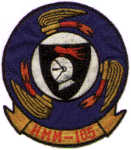
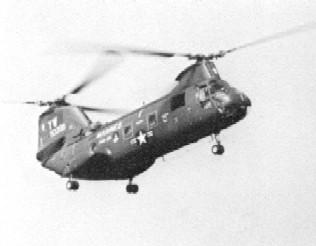 The first fix for the sand problem was successful and the aircraft started to fly in country after an engine air intake retrofit. The second major problem with the design was the tail falling off in flight. This could ruin your whole day. Most failures were catastrophic for both the aircraft and the crew. The forward and aft rotor systems operate in opposite directions. One is going clockwise and the other is going counter clockwise. They must maintain their synchronization because the blades overlap. Twisting motion under heavy loads caused the fuselage to twist and fail in the aft pylon area. The fix was an iron tail modification that was accomplished when the aircraft was overhauled. Some modifications may have been made in the field. It was an urgent modification. The aircraft s new designation for the iron tail version was CH-46D. The General Electric T-58-10 engines were excellent power plants that were used in several different helicopter models. The Navy was using these engines in the H-3 and H-2 helicopters and DOD had a good inventory of these engines. We had no major design problems with the engines or transmissions. The hydraulics systems and the flight controls were well designed. The CH-46 used a rotor blade built on composite technology. Major components in our rotor blades were the aluminum-extruded spar, a trailing box section and a flexible leading edge. The trailing and leading edges were bonded to the spar. We didn t have a blade design problem, but we were going to identify a problem with high time blades in the future that would required a major design change.
The first fix for the sand problem was successful and the aircraft started to fly in country after an engine air intake retrofit. The second major problem with the design was the tail falling off in flight. This could ruin your whole day. Most failures were catastrophic for both the aircraft and the crew. The forward and aft rotor systems operate in opposite directions. One is going clockwise and the other is going counter clockwise. They must maintain their synchronization because the blades overlap. Twisting motion under heavy loads caused the fuselage to twist and fail in the aft pylon area. The fix was an iron tail modification that was accomplished when the aircraft was overhauled. Some modifications may have been made in the field. It was an urgent modification. The aircraft s new designation for the iron tail version was CH-46D. The General Electric T-58-10 engines were excellent power plants that were used in several different helicopter models. The Navy was using these engines in the H-3 and H-2 helicopters and DOD had a good inventory of these engines. We had no major design problems with the engines or transmissions. The hydraulics systems and the flight controls were well designed. The CH-46 used a rotor blade built on composite technology. Major components in our rotor blades were the aluminum-extruded spar, a trailing box section and a flexible leading edge. The trailing and leading edges were bonded to the spar. We didn t have a blade design problem, but we were going to identify a problem with high time blades in the future that would required a major design change.
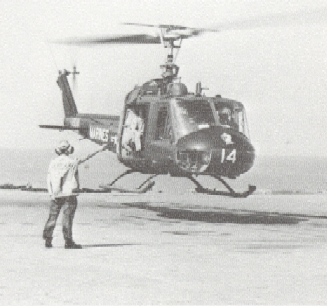 For the time being, we would be flying these old veterans of Vietnam. Even being old aircraft didn t keep our aircraft down. You can overcome aircraft age problems with parts and the right people. We were going to be blessed with both. Bell helicopters can eat up tail rotor blades and they can have some fuselage problems with advanced age. During this period of time, UH1E blades, flight controls and engines were good.
For the time being, we would be flying these old veterans of Vietnam. Even being old aircraft didn t keep our aircraft down. You can overcome aircraft age problems with parts and the right people. We were going to be blessed with both. Bell helicopters can eat up tail rotor blades and they can have some fuselage problems with advanced age. During this period of time, UH1E blades, flight controls and engines were good.
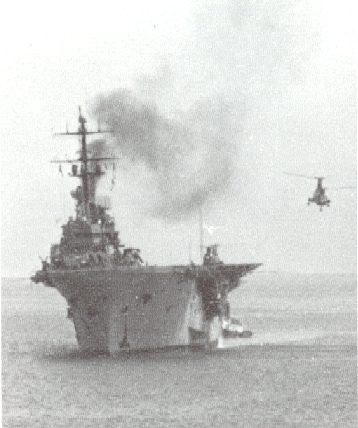 We were hot seating pilots on the flight deck with the aircraft turning at 100%. You get more pilots qualified during a shorter period of time using the hot seat method. A pilot s helmet hit the rotor brake switch getting in or out of his seat and actuated the rotor brake. The friction caused by the rotor brake caused a fire in the forward transmission area destroying that part of the aircraft. We were having a bad day. Since the damage to the aircraft was beyond our capability to repair, the ship decided to barge the aircraft to Cubi Point for further deposition. We had about 2 hours to do an accident investigation before the aircraft was going to disappear. The ship was going to up anchor and depart the area on schedule.
We were hot seating pilots on the flight deck with the aircraft turning at 100%. You get more pilots qualified during a shorter period of time using the hot seat method. A pilot s helmet hit the rotor brake switch getting in or out of his seat and actuated the rotor brake. The friction caused by the rotor brake caused a fire in the forward transmission area destroying that part of the aircraft. We were having a bad day. Since the damage to the aircraft was beyond our capability to repair, the ship decided to barge the aircraft to Cubi Point for further deposition. We had about 2 hours to do an accident investigation before the aircraft was going to disappear. The ship was going to up anchor and depart the area on schedule.
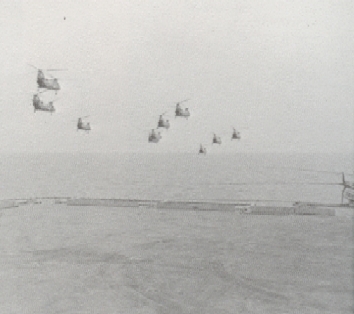 Could we go in and get our POW out without killing them and ourselves at the same time? It didn t look good. As we steamed up and down the coast, we practiced and practiced some more. We loaded the Battalion Landing Team and launched for the coast and then turned back before we crossed the coast. When we didn't practice with the Battalion, we test fired our guns. The North Vietnamese didn t know what we were going to do. The weather was playing games with out flight operations. We had lots of fog and overcast conditions. The North Vietnamese used that type of weather to approach our ships with their small boats and aircraft. We were going to general quarters on a regular basis for about a week. We could see them approaching our position on radar, but we never did make visual contact. We had two helicopters flying cover over our ships most of the time. They had a mission to intercept two radar contacts that were flying 30 miles from the ship. They closed to within 10 miles before the contact turned and ran for the coast. This may have been the first time helicopters were used as interceptors. I m not sure what they would have done had they found the enemy.
Could we go in and get our POW out without killing them and ourselves at the same time? It didn t look good. As we steamed up and down the coast, we practiced and practiced some more. We loaded the Battalion Landing Team and launched for the coast and then turned back before we crossed the coast. When we didn't practice with the Battalion, we test fired our guns. The North Vietnamese didn t know what we were going to do. The weather was playing games with out flight operations. We had lots of fog and overcast conditions. The North Vietnamese used that type of weather to approach our ships with their small boats and aircraft. We were going to general quarters on a regular basis for about a week. We could see them approaching our position on radar, but we never did make visual contact. We had two helicopters flying cover over our ships most of the time. They had a mission to intercept two radar contacts that were flying 30 miles from the ship. They closed to within 10 miles before the contact turned and ran for the coast. This may have been the first time helicopters were used as interceptors. I m not sure what they would have done had they found the enemy.
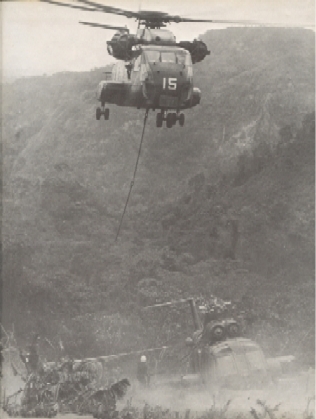 The mission was to transport hospital building supplies to a village at the 5000 foot level in the local mountains around Clark Air Force Base. Our aircraft was lost trying to land on a small flat spot on the side of a mountain. The aircraft came to rest hanging over the edge of the landing zone. The accident board determined that the aircraft was overloaded. The recovery crew determined that the aircraft could not be recovered from that altitude with the equipment that we had at the time. Hovering out of ground effect at 5000 feet is difficult. There are no roads in that area and the village had recently practiced cannibalism. The engines and transmissions could be salvaged and we could do it with CH-53D. The fuselage would have to stay where it landed. The aircraft had to be secured to the mountainside before we could work on the engines and transmissions. It wouldn t take much of a jolt for the aircraft to roll down the mountainside. The solution was to sink posts in the mountain and cable the aircraft to the posts. We left the natives with some tools and maybe they found a use for the fuselage. The natives were nice, but the troops didn t want to stay overnight in that village. Can t imagine why?
The mission was to transport hospital building supplies to a village at the 5000 foot level in the local mountains around Clark Air Force Base. Our aircraft was lost trying to land on a small flat spot on the side of a mountain. The aircraft came to rest hanging over the edge of the landing zone. The accident board determined that the aircraft was overloaded. The recovery crew determined that the aircraft could not be recovered from that altitude with the equipment that we had at the time. Hovering out of ground effect at 5000 feet is difficult. There are no roads in that area and the village had recently practiced cannibalism. The engines and transmissions could be salvaged and we could do it with CH-53D. The fuselage would have to stay where it landed. The aircraft had to be secured to the mountainside before we could work on the engines and transmissions. It wouldn t take much of a jolt for the aircraft to roll down the mountainside. The solution was to sink posts in the mountain and cable the aircraft to the posts. We left the natives with some tools and maybe they found a use for the fuselage. The natives were nice, but the troops didn t want to stay overnight in that village. Can t imagine why?
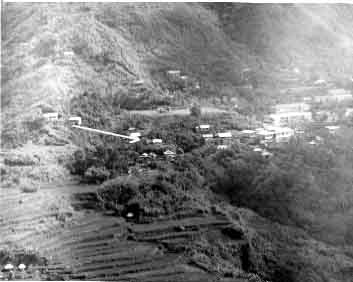 The most interesting event in a typical technician s day could be an aircraft discrepancy. The discrepancy could be more interesting than food or sleep. We sometimes have competition between technicians who want to work on an interesting aircraft discrepancy. A combination of liberty ports with a no fly schedule or a heavy flying schedule with the Squadron at sea makes good maintenance sense. We had two trips to Hong Kong, two trips to Singapore and one liberty in Manila. In Manila we were tied to the dock. All were great for troop morale. We didn t have any flying in Hong Kong and only a few humanitarian hops in Singapore and Manila.
The most interesting event in a typical technician s day could be an aircraft discrepancy. The discrepancy could be more interesting than food or sleep. We sometimes have competition between technicians who want to work on an interesting aircraft discrepancy. A combination of liberty ports with a no fly schedule or a heavy flying schedule with the Squadron at sea makes good maintenance sense. We had two trips to Hong Kong, two trips to Singapore and one liberty in Manila. In Manila we were tied to the dock. All were great for troop morale. We didn t have any flying in Hong Kong and only a few humanitarian hops in Singapore and Manila.
